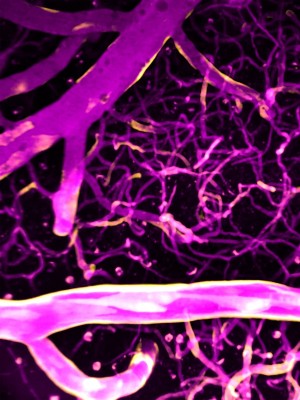December 07, 2017 | David Kohn

Discovery Could Enable Early Diagnosis of Autism and Other Cognitive Deficits
Some expectant parents play classical music for their unborn babies, hoping to boost their children’s cognitive capacity. While some research supports a link between prenatal sound exposure and improved brain function, scientists had not identified any structures responsible for this link in the developing brain.
A new study by University of Maryland School of Medicine (UMSOM) scientists, along with colleagues from the University of Maryland College Park, is the first to identify a mechanism that could explain an early link between sound input and cognitive function, often called the “Mozart effect.” Working with an animal model, the researchers found that a type of cell in the brain’s primary processing area during early development, long thought to have no role in transmitting sensory information, may conduct such signals after all.
The results, which could have implications for the early diagnosis of autism and other cognitive deficits, were published earlier this week in the Proceedings of the National Academy of Sciences.
“Our work is the first to suggest that very early in brain development, sound becomes an important sense,” said Amal Isaiah, MBBS, DPhil, assistant professor of otorhinolaryngology at UMSOM and one of the principal authors. “It appears that the neurons that respond to sound play a role in the early functional organization of the cortex. This is new, and it is really exciting.”
Working with young ferrets, Dr. Isaiah and Patrick Kanold, PhD, a professor of biology at University of Maryland College Park, observed sound-induced nerve impulses in subplate neurons, which help guide the formation of neural circuits in the same way that a scaffolding helps a construction crew erect a new building. This is the first time such impulses have been seen in these neurons. During development, subplate neurons are among the first neurons to form in the cerebral cortex—the outer part of the mammalian brain that controls perception, memory and, in humans, higher functions such as language and abstract reasoning.
The role of subplate neurons is thought to be temporary. Once the brain’s permanent neural circuits form, most subplate neurons disappear. Researchers assumed that subplate neurons had no role in transmitting sensory information, given their transient nature.
Scientists had thought that mammalian brains transmit their first sensory signals in response to sound after the thalamus, a large relay center, fully connects to the cerebral cortex. Studies from some mammals demonstrate that the connection of the thalamus and the cortex also coincides with the opening of the ear canals, which allows sounds to activate the inner ear. This timing provided support for the traditional model of when sound processing begins in the brain.
However, researchers had struggled to reconcile this conventional model with observations of sound-induced brain activity much earlier in the developmental process. Until Kanold, senior author of the paper, and his colleagues directly measured the response of subplate neurons to sound, the phenomenon had largely been overlooked.
 “Previous research documented brain activity in response to sound during early developmental phases, but it was hard to determine where in the brain these signals were coming from,” Prof. Kanold said. “Our study is the first to measure these signals in an important cell type in the brain, providing important new insights into early sensory development in mammals.”
“Previous research documented brain activity in response to sound during early developmental phases, but it was hard to determine where in the brain these signals were coming from,” Prof. Kanold said. “Our study is the first to measure these signals in an important cell type in the brain, providing important new insights into early sensory development in mammals.”
By identifying a source of early sensory nerve signals, the current study could lead to new ways to diagnose autism and other cognitive deficits that emerge early in development. Early diagnosis is an important first step toward early intervention and treatment.
The next step is to begin studying in more detail how subplate neurons affect brain development. There are many avenues of research: for instance, the researchers say that the neurons might play a role in some cognitive conditions such as autism.
“This collaboration between our school and researchers at College Park has yielded fascinating results,” said E. Albert Reece, MD, PhD, MBA, executive vice president for medical affairs at the University of Maryland, the John Z. and Akiko K. Bowers Distinguished Professor and dean of UMSOM. He is a top expert on pregnancy in diabetes, and has spent much of his career studying the topic. “This is basic research, but it has important potential implications for many child neurodevelopmental disorders. I look forward to seeing with these talented researchers find as their research goes forward in the future.”
About the University of Maryland School of Medicine
Commemorating its 210th Anniversary, the University of Maryland School of Medicine was chartered in 1807 as the first public medical school in the United States. It continues today as one of the fastest growing, top-tier biomedical research enterprises in the world -- with 43 academic departments, centers, institutes, and programs; and a faculty of more than 3,000 physicians, scientists, and allied health professionals, including members of the National Academy of Sciences, and a distinguished recipient of the Albert E. Lasker Award in Medical Research. With an operating budget of more than $1 billion, the School of Medicine works closely in partnership with the University of Maryland Medical Center and Medical System to provide research-intensive, academic and clinically-based care for more than 1.2 million patients each year. The School has over 2,500 students, residents, and fellows, and nearly $450 million in extramural funding, with more than half of its academic departments ranked in the top 20 among all public medical schools in the nation in research funding. As one of the seven professional schools that make up the University of Maryland, Baltimore campus, the School of Medicine has a total workforce of nearly 7,000 individuals. The combined School and Medical System (“University of Maryland Medicine”) has a total budget of $5 billion and an economic impact of nearly $15 billion on the state and local community. The School of Medicine faculty, which ranks as the 8th-highest public medical school in research productivity, is an innovator in translational medicine with 600 active patents and 24 start-up companies. The School works locally, nationally, and globally, with research and treatment facilities in 36 countries around the world. Visit medschool.umaryland.edu/
About the College of Computer, Mathematical, and Natural Sciences?
The College of Computer, Mathematical, and Natural Sciences at the University of Maryland educates more than 7,000 future scientific leaders in its undergraduate and graduate programs each year. The college's 10 departments and more than a dozen interdisciplinary research centers foster scientific discovery with annual sponsored research funding exceeding $150 million.
Learn More
Contact
Office of Public Affairs
655 West Baltimore Street
Bressler Research Building 14-002
Baltimore, Maryland 21201-1559
Contact Media Relations
(410) 706-5260
Related stories

Thursday, November 21, 2024
UM School of Medicine Researchers Link Snoring to Behavioral Problems in Adolescents without Declines in Cognition
Adolescents who snore frequently were more likely to exhibit behavior problems such as inattention, rule-breaking, and aggression, but they do not have any decline in their cognitive abilities, according to a new study conducted by researchers at the University of Maryland School of Medicine (UMSOM). This is the largest study to date tracking snoring in children from elementary school through their mid-teen years and it provides an important update to parents struggling with what medical measures to take to help manage snoring in their children.

Tuesday, April 25, 2023
Immune System Sculpts Rat Brains During Development
Researchers have established that biological sex plays a role in determining an individual’s risk of brain disorders. For example, boys are more likely to be diagnosed with behavioral conditions like autism or attention deficit disorder, whereas women are more likely to suffer from anxiety disorders, depression, or migraines. However, experts do not fully understand how sex contributes to brain development, particularly in the context of these diseases. They think, in part, it may have something to do with the differing sizes of certain brain regions.

Friday, March 31, 2023
Traumatic Brain Injury Interferes with Immune System Cells’ Recycling Process in Brain Cells
Each year about 1.5 million people in the U.S. survive a traumatic brain injury due to a fall, car accident, or a sports injury, which can cause immediate and long-term disability.

Friday, January 06, 2023
UM School of Medicine Scientists Create First Extensive Brain Cell Data Repository
Neuroscience researchers now have access to 50 million brain cells to better understand how the brain develops and functions or changes with disease or trauma. Last month, scientists at the University of Maryland School of Medicine’s (UMSOM) Institute for Genome Sciences (IGS) unveiled a “one-stop shop” for brain cell data called the Neuroscience Multi-Omic Archive (NeMO Archive). This archive is now available to neuroscience researchers to transform their understanding of the complex workings of the brain.

Monday, November 14, 2022
Brain Area Thought to Impart Consciousness, Behaves Instead Like an Internet Router
Tucked underneath the brain’s outer, wrinkly cortex is a deeply mysterious area, known as the claustrum. This region has long been known to exchange signals with much of the cortex, which is responsible for higher reasoning and complex thought. Because of the claustrum’s extensive connections, the legendary scientist Francis Crick, PhD, of DNA-discovery fame, first postulated in 2005 that the claustrum is the seat of consciousness. In other words, the region of the brain enabling awareness of the world and ourselves.

Wednesday, July 21, 2021
University of Maryland School of Medicine Study Finds Calcium Precisely Directs Blood Flow in the Brain
University of Maryland School of Medicine and University of Vermont researchers have shown how the brain communicates to blood vessels when in need of energy, and how these blood vessels respond by relaxing or constricting to direct blood flow to specific brain regions.

Tuesday, April 13, 2021
UM School of Medicine Researchers Find Habitual Snoring Linked to Significant Brain Changes in Children
Children who regularly snore have structural changes in their brain that may account for the behavioral problems associated with the condition, including lack of focus, hyperactivity, and learning difficulties at school. That is the finding of a new study conducted by researchers at the University of Maryland School of Medicine (UMSOM), which was published today in the journal Nature Communications.

Wednesday, September 25, 2019
Dr. Tracy Bale Elected President of the International Brain Research Organization
Tracy L. Bale, PhD, Professor of Pharmacology and Director of the Center for Epigentic Research in Child Health & Brain Development has been elected President of the International Brain Research Organization.

Wednesday, September 18, 2019
Study Questions Use of Routine Sleep Studies to Evaluate Snoring in Children
Pediatricians routinely advise parents of children who snore regularly and have sleepiness, fatigue or other symptoms consistent with sleep disordered breathing, to get a sleep study; this can help determine whether their child has obstructive sleep apnea, which is often treated with surgery to remove the tonsils and adenoids (adenotonsillectomy). Often pediatricians make surgery recommendations based on the results of this sleep study.

Monday, April 29, 2019
UMSOM’s Reading on the Brain Program Teaches Baltimore City Elementary Students About the Brain-Building Power of Reading
Acting Baltimore City Mayor Jack Young joined 4th and 5th grade students at Callaway Elementary School to help paint a mural about the brain. It was all part of Reading on the Brain, a University of Maryland School of Medicine (UMSOM) program to teach young students about the importance of reading and how reading can stimulate brain development and inspire future success. Tracy Bale, PhD, is leading the pilot program, which also emphasizes science and helps children to understand how the brain works.

Thursday, March 28, 2019
Allergic Reactions Play Role in Sexual Behavior Development in Unborn Males and Females, UMSOM Research Shows
Researchers at the University of Maryland School of Medicine and colleagues at Ohio State University have discovered that allergic reactions trigger changes in brain behavior development in unborn males and females. This latest brain development discovery will ultimately help researchers better understand how neurological conditions can differ between men and women.

Friday, March 01, 2019
UMSOM Researchers Discover Clues to Brain Differences Between Males and Females
Researchers at the University of Maryland School of Medicine have discovered a mechanism for how androgens -- male sex steroids -- sculpt brain development. The research, conducted by Margaret M. McCarthy, Ph.D., Professor of Pharmacology and Chair of the Department of Pharmacology, could ultimately help researchers understand behavioral development differences between males and females.

Wednesday, June 27, 2018
UM School of Medicine's Scott Strome, MD, Named Dean of Medical College at University of Tennessee Health Science Center in Memphis
Scott Strome, MD, FACS, Professor and Chair of the Department of Otorhinolaryngology – Head & Neck Surgery at the University of Maryland School of Medicine (UMSOM), has been named Executive Dean, College of Medicine and Vice Chancellor for Health Affairs at the University of Tennessee Health Science Center in Memphis, Tenn., effective October 1, 2018. UMSOM Dean E. Albert Reece, MD, PhD, MBA, announced that, Rodney Taylor, MD, MSPH, Associate Professor of Otorhinolaryngology-Head & Neck Surgery, will serve as Interim Chair.
